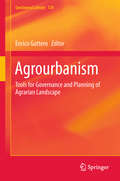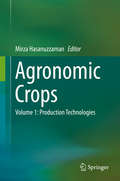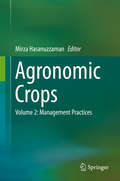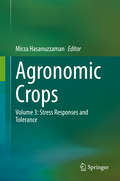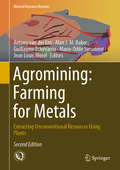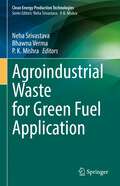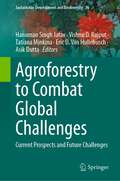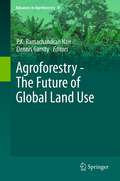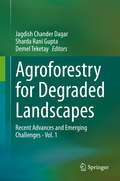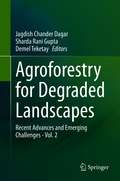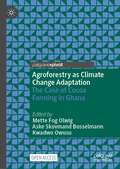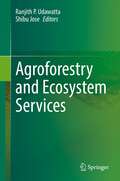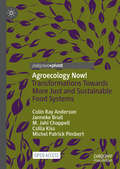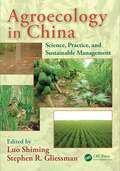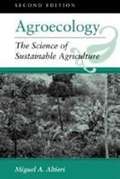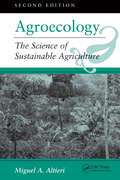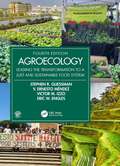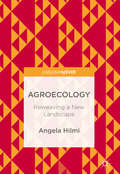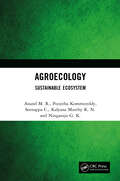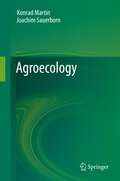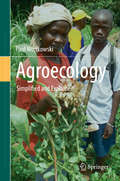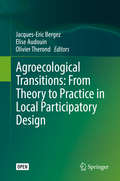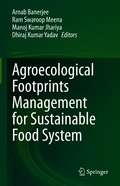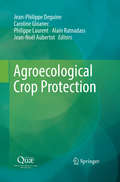- Table View
- List View
AGS Biology
by Daniel A. Mcfarland Helen ParkeThis textbook on biology contains fourteen chapters with appendices, glossary and index, and a brief guide on how to use the book by a student.
Agrourbanism: Tools for Governance and Planning of Agrarian Landscape (GeoJournal Library #124)
by Enrico GotteroThis book provides a much needed overview of the agrourbanism topic in the context of territorial studies. It carefully looks at rural, urban, periurban farming in both professional and unprofessional capacities as one of the main sustainable forms of land use and management. This cutting edge text explores the various forms of agricultural and urban planning, as well as the main innovations that the agro-urban approach entails in terms of governance, spatial dimensions and functions. Agrourbanism provides a breadth of information and serves as a practical study of concerns facing policy and decision makers, planners and landscape managers, as well as farmers, managers of protected areas, local authorities and local action groups. As such this book is suitable as a course accompaniment to provide an overview of the complexity of agro-urban issues.
Agronomic Crops: Volume 1: Production Technologies
by Mirza HasanuzzamanAgronomic crops have been used to provide foods, beverages, fodders, fuels, medicines and industrial raw materials since the dawn of human civilization. Today, agronomic crops are being cultivated by employing scientific methods instead of traditional methods. However, in the current era of climate change, agronomic crops are subjected to various environmental stresses, which results in substantial yield loss. To meet the food demands of the ever-increasing global population, new technologies and management practices are being adopted to boost yield and maintain productivity under both normal and adverse conditions. Scientists are now exploring a variety of approaches to the sustainable production of agronomic crops, including varietal development, soil management, nutrient and water management, pest management, etc. Researchers have also made remarkable progress in developing stress tolerance in crops through different approaches. However, achieving optimal production to meet the increasing food demand is an open challenge. Although there have been numerous publications on the above-mentioned problems, and despite the extensive research being conducted on them, there is hardly any comprehensive book available. In response, this book offers a timely resource, addressing all aspects of production technologies, management practices and stress tolerance in agronomic crops in a single volume.
Agronomic Crops: Volume 2: Management Practices
by Mirza HasanuzzamanAgronomic crops have provided food, beverages, fodder, fuel, medicine and industrial raw materials since the beginning of human civilization. More recently, agronomic crops have been cultivated using scientific rather than traditional methods. However, in the current era of climate change, agronomic crops are suffering from different environmental stresses that result in substantial yield loss. To meet the food demands of the ever-increasing global population, new technologies and management practices are being adopted to boost yields and maintain productivity under both normal and adverse conditions. Further, in the context of sustainable agronomic crop production, scientists are adopting new approaches, such as varietal development, soil management, nutrient and water management, and pest management. Researchers have also made remarkable advances in developing stress tolerance in crops. However, the search for appropriate solutions for optimal production to meet the increasing food demand is still ongoing. Although there are several publications on the recent advances in these areas, there are few comprehensive resources available covering all of the recent topics. This timely book examines all aspects of production technologies, management practices and stress tolerance of agronomic crops.
Agronomic Crops: Volume 3: Stress Responses and Tolerance
by Mirza HasanuzzamanAgronomic crops have been a source of foods, beverages, fodders, fuels, medicines and industrial raw materials since the dawn of human civilization. Over time, these crops have come to be cultivated using scientific methods instead of traditional methods. However, in the era of climate change, agronomic crops are increasingly subjected to various environmental stresses, which results in substantial yield loss. To meet the food demands of the ever-increasing global population, new technologies and management practices are being adopted to boost yield and maintain productivity under both normal and adverse conditions. To promote the sustainable production of agronomic crops, scientists are currently exploring a range of approaches, which include varietal development, soil management, nutrient and water management, pest management etc. Researchers have also made remarkable progress in developing stress tolerance in crops through various approaches. However, finding solutions to meet the growing food demands remains a challenge. Although there are several research publications on the above-mentioned problems, there are virtually no comprehensive books addressing all of the recent topics. Accordingly, this book, which covers all aspects of production technologies, management practices, and stress tolerance of agronomic crops in a single source, offers a highly topical guide.
Agromining: Extracting Unconventional Resources Using Plants (Mineral Resource Reviews)
by Antony van der Ent Alan J. M. Baker Guillaume Echevarria Marie-Odile Simonnot Jean Louis MorelThis second and expanded edition of the first book on agromining (phytomining) presents a comprehensive overview of the metal farming & recovery of the agromining production chain. Agromining is an emerging technology that aims to transform the extraction of sources of target elements not accessible by traditional mining and processing techniques. Agromining, which is based on sustainable development, uses hyperaccumulator plants as 'metal crops' farmed on sub-economic soils or minerals wastes to obtain valuable target elements. This volume is edited and authored by the pioneers in the rapidly expanding field of agromining and presents the latest insights and developments in the field. This book provides in-depth information on the global distribution and ecology of hyperaccumulator plants, their biogeochemical pathways, the influence of rhizosphere microbes, the physiology and molecular biology of hyperaccumulation, as well as aspects of propagation and conservation of these unusual plants. It describes the agronomy of metal crops and opportunities for incorporating agromining into rehabilitation and mine closure, including test cases for agromining of nickel, cobalt, manganese, arsenic, selenium, cadmium, zinc, thallium, rare earth elements and platinum group elements. Since the first edition was published, there have successful nickel agromining field trials in the tropics (in Malaysia and Guatemala), and these are presented in a dedicated case study chapter. Other new chapters focus on the processing of bio-ore for elements other than nickel, such as rare earth elements and cadmium, and on agromining from industrial wastes such as tailings, and industrial by-products and sites. Furthermore, the book features two new chapters that provide a comprehensive assessment of accumulation a very wide range elements from the Periodic Table in various plant species around the globe, and a chapter on practical methods for discovery of hyperaccumulator plant species in the field and in the herbarium. This book is of interest to environmental professionals in the minerals industry, government regulators, and academics.
Agroindustrial Waste for Green Fuel Application (Clean Energy Production Technologies)
by Neha Srivastava Bhawna Verma P. K. MishraThe book revisit in depth scope of agroindustrial waste for enhancement in biofuels production on practical ground. It explores and discusses various cellulose rich agro-wastes along with low cost, advance technology based options for sustainable biofuels production. Lignocellulosic biomasses are potential producer of biofuels due to renewable nature and huge occurrence. Cellulose is the main polymeric component of these biomasses apart from lignin and hemicellulose. It can be converted into fermentable sugars using cellulase enzyme which can be further converted into the renewable energy sources such as biohydrogen, bioethanol, biogas and butanol. Chapters in this title provide exclusive and critical analysis of specific biofuels production process only from lignocellulosic biomass, based on their type, property, availability, cost and most important sugar or cellulose content along with the simplest process search for converting these biomasses into biofuels to make overall process more simple and economical.It is a useful guide for academician and environmentalist who are working to explore feasible advantages associated with these kinds of waste management and their effective valorization. It is also a great resource for senior undergraduate and graduate students, researchers, professionals, and other interested individuals/groups working in the field of biofuel/bioenergy.
Agroforestry to Combat Global Challenges: Current Prospects and Future Challenges (Sustainable Development and Biodiversity #36)
by Hanuman Singh Jatav Vishnu D. Rajput Tatiana Minkina Eric D. Van Hullebusch Asik DuttaThis edited book brings out comprehensive insights on agro-forestry systems to cope up climate change globally. The main essence of this book is to unfurl the positive sides of agri-silvipastoral system to reduce greenhouse gases (GHGs) and temperature. Agro-forestry can be defined as the farming practice combining field crops, perennial trees and livestock. The impact of agro-forestry on ecology is implacable which is thoroughly discussed under different heads in this book. In addition, the book is bundle of different novel sections including tables, graphical representation, and figures showcasing the bright side of agro-forestry system. Furthermore, trees which are important component of boosting socio-economic conditions, especially for the indigenous populations have also been discussed meticulously. Hence, all together this book deciphers an account of agro-forestry practices in society and environment along with the major pros- and cons- of the system. Undoubtedly, this information could enrich the scholarly knowledge for graduate research fellows, teachers, scientists, researchers, and environmentalists in gaining multifaceted information of agro-forestry system in both ecological and economical aspects. Different research highlights will be helpful for the policy makers to implement this novel practice in intensive production systems and harness the maximum benefits out of this.
Agroforestry - The Future of Global Land Use (Advances in Agroforestry #9)
by P.K. Ramachandran Nair Dennis GarrityThis volume contains a solid body of the current state of knowledge on the various themes and activities in agroforestry worldwide. It is organized into three sections: the Introduction section consists of the summaries of six keynote speeches at the 2nd World Congress of Agroforestry held in Nairobi, Kenya, in 2009; that is followed by two sections of peer-reviewed thematic chapters grouped as "Global Perspectives" (seven chapters) and "Regional Perspectives" (eleven chapters), authored by professional leaders in their respective agroforestry-related fields worldwide. A total of 130 professionals from institutions in 33 countries in both developing and the industrialized temperate regions of the world contributed to the book as chapter authors and/or reviewers. Thus, the book presents a comprehensive and authoritative account of the global picture of agroforestry today.
Agroforestry for Degraded Landscapes: Recent Advances and Emerging Challenges - Vol.1
by Jagdish Chander Dagar Sharda Rani Gupta Demel TeketayThis book presents various aspects of agroforestry research and development, as well as the latest trends in degraded landscape management. Over the last four decades, agroforestry research (particularly on degraded landscapes) has evolved into an essential problem-solving science, e.g. in terms of sustaining agricultural productivity, improving soil health and biodiversity, enhancing ecosystem services, supporting carbon sequestration and mitigating climate change. This book examines temperate and tropical agroforestry systems around the world, focusing on traditional and modern practices and technologies used to rehabilitate degraded lands. It covers the latest research advances, trends and challenges in the utilization and reclamation of degraded lands, e.g. urban and peri-urban agroforestry, reclamation of degraded landscapes, tree-based multi-enterprise agriculture, domestication of high-value halophytes, afforestation of coastal areas, preserving mangroves and much more. Given its scope, the book offers a valuable asset for a broad range of stakeholders including farmers, scientists, researchers, educators, students, development/extension agents, environmentalists, policy/decision makers, and government and non-government organizations.
Agroforestry for Degraded Landscapes: Recent Advances and Emerging Challenges - Vol. 2
by Jagdish Chander Dagar Sharda Rani Gupta Demel TeketayThis book presents various aspects of agroforestry research and development, as well as the latest trends in degraded landscape management. Over the last four decades, agroforestry research (particularly on degraded landscapes) has evolved into an essential problem-solving science, e.g. in terms of sustaining agricultural productivity, improving soil health and biodiversity, enhancing ecosystem services, supporting carbon sequestration and mitigating climate change. This book examines temperate and tropical agroforestry systems around the world, focusing on traditional and modern practices and technologies used to rehabilitate degraded lands. It covers the latest research advances, trends and challenges in the utilization and reclamation of degraded lands, e.g. urban and peri-urban agroforestry, reclamation of degraded landscapes, tree-based multi-enterprise agriculture, domestication of high-value halophytes, afforestation of coastal areas, preserving mangroves and much more. Given its scope, the book offers a valuable asset for a broad range of stakeholders including farmers, scientists, researchers, educators, students, development/extension agents, environmentalists, policy/decision makers, and government and non-government organizations.
Agroforestry as Climate Change Adaptation: The Case of Cocoa Farming in Ghana
by Mette Fog Olwig Aske Skovmand Bosselmann Kwadwo OwusuThis open access book provides multidisciplinary perspectives on the potential of agroforestry to mitigate the negative impacts of climate change on cocoa production. Against the backdrop of increasingly precarious farmer livelihoods, it focuses on cocoa-agroforestry in Ghana – the second largest producer of cocoa in the world. Taking the reader on a journey across experimental plots and on-farm studies, the book delivers a holistic understanding of cocoa-agroforestry. Chapters examine historical yield and climate interactions, the effects of heat and drought on cocoa plants and the role of differing shade trees on soil fertility, yields, pests and diseases. The book discusses the socioeconomics of shade tree management, including cost-benefits, tree rights and competition for natural resources emphasizing policy implications and recommendations.Taking a multidisciplinary approach to climate-agriculture interactions, the book provides an innovative understanding of agroforestry and perennial cropping systems that goes beyond the Ghanaian cocoa belt. It is of relevance to students, researchers, farmers, practitioners and policymakers working with agroforestry and climate change adaptation.This is an open access book.
Agroforestry and Ecosystem Services
by Shibu Jose Ranjith P. UdawattaThis book is a state-of-the-art compilation of the latest information on ecosystem services of agroforestry. The last two decades have seen a surge in literature on the ecosystem services of sustainable agriculture practices, including that of agroforestry; however, compilation and synthesis of such information from agroforestry have been limited. This book fills that void by bringing in a number of experts from around the world. In addition to presenting the multiple dimensions of ecosystem services provided by major agroforestry practices, the book also offers case studies from both tropical and temperate regions of the world.Information from this book can be used to design land management practices for climate change mitigation, ecosystem benefits, agricultural productivity and sustainability, and for survival and profitability of family farms and to conserve biodiversity. While synthesizing information of the biophysical aspects of ecosystem services, the book also outlines the socioeconomic and policy dimensions, including appropriate incentive models to enhance adoption of agroforestry so that society at large can enjoy these important benefits
Agroecology Now!: Transformations Towards More Just and Sustainable Food Systems
by Colin Ray Anderson Janneke Bruil M. Jahi Chappell Csilla Kiss Michel Patrick PimbertThis open access book develops a framework for advancing agroecology transformations focusing on power, politics and governance. It explores the potential of agroecology as a sustainable and socially just alternative to today’s dominant food regime. Agroecology is an ecological approach to farming that addresses climate change and biodiversity loss while contributing to the Sustainable Development Goals. Agroecology transformations represent a challenge to the power of corporations in controlling food system and a rejection of the industrial food systems that are at the root of many social and ecological ills. In this book the authors analyse the conditions that enable and disable agroecology’s potential and present six ‘domains of transformation’ where it comes into conflict with the dominant food system. They argue that food sovereignty, community-self organization and a shift to bottom-up governance are critical for the transformation to a socially just and ecologically viable food system. This book will be a valuable resource to researchers, students, policy makers and professionals across multidisciplinary areas including in the fields of food politics, international development, sustainability and resilience.
Agroecology in China: Science, Practice, and Sustainable Management (Advances in Agroecology #22)
by Stephen R. Gliessman Luo ShimingKey features: Reviews the development of agroecology in China, including research, practice, management, and education regarding challenges for rural and agricultural progress Presents information from sources not readily available in the West about agricultural development in China during the last several decades Provides models and indicates starting points for future research and practice Addresses how to meet future challenges of agroecosystems from the field to the table in China from scientific, technological, and management perspectives During the past 30 years, industrialization has fundamentally changed traditional rural life and agricultural practices in China. While the incomes of farmers have increased, serious issues have been raised concerning the environment, resource depletion, and food safety. In response, the Chinese government and Chinese scientists encouraged eco-agriculture, the practice of agroecology principles and philosophy, as a way to reduce the negative consequences of large-scale industrialized systems of farming. Agroecology in China: Science, Practice, and Sustainable Management represents the work of experts and leaders who have taught, researched, and expanded Chinese agroecology and eco-agriculture for more than 30 years. It reviews decades of agricultural change to provide an integrated analysis of the progress of research and development in agroecological farming practices. The book contains research on traditional and newly developed agricultural systems in China, including intercropping systems, rainfall harvest systems, and rice–duck, rice–fish, and rice–frog co-culture systems. It covers current eco-agriculture practices in the major regions of China according to climate conditions. The book closes with a discussion of the major technical approaches, necessary policy support, and possible major development stages that must occur to allow broader agroecological implementations toward the sustainability of future food systems in China. Presenting eco-agriculture systems that are somewhat unique in comparison to those of the United States, Latin America, and Europe, Agroecology in China gives insight on how Chinese agroecologists, under the political and cultural systems specific to China, have created a strong foundation for ecologically sound agroecosystem design and management that can be applied and adapted to food systems elsewhere in the world. By using selected regional examinations of agroecological efforts in China as examples, this book provides models of how to conduct research on a broad range of agroecosystems found worldwide.
Agroecology: The Science of Sustainable Agriculture (2nd Edition)
by Miguel A. AltieriThis new edition builds on the explosion of research on sustainable agriculture since the late 1980s. By separating myth from reality, Miguel Altieri extracts the key principles of sustainable agriculture and expounds on management systems that "really work. " Providing case studies of sustainable rural development in developing countries, he goes beyond a mere description of practices to include data that reveal the socioeconomic and environmental impacts of alternative projects. Each chapter of Agroecology has been enriched and updated with the latest research results from around the world. New emphasis has been placed on such issues as the ecological economics of agriculture, policy changes needed for promoting sustainable agriculture, rural development in the Third World, the role of biodiversity in agriculture, and new research methodologies.
Agroecology: The Science Of Sustainable Agriculture, Second Edition (Agrarian Change And Peasant Studies #7)
by Miguel A AltieriThis new edition builds on the explosion of research on sustainable agriculture since the late 1980s. By separating myth from reality, Miguel Altieri extracts the key principles of sustainable agriculture and expounds on management systems that "really work." Providing case studies of sustainable rural development in developing countries, he goes beyond a mere description of practices to include data that reveal the socioeconomic and environmental impacts of alternative projects. Each chapter of Agroecology has been enriched and updated with the latest research results from around the world. New emphasis has been placed on such issues as the ecological economics of agriculture, policy changes needed for promoting sustainable agriculture, rural development in the Third World, the role of biodiversity in agriculture, and new research methodologies.
Agroecology: Leading the Transformation to a Just and Sustainable Food System (Advances in Agroecology)
by Stephen R. Gliessman V. Ernesto Méndez Victor M. Izzo Eric W. EnglesAgroecology is at the forefront of transforming our food systems. This bestselling textbook provides the essential foundation for understanding this transformation in all its components: agricultural, ecological, economic, social, cultural, and political. It presents a case for food system change, explains the principles and practices underlying the ecological approach to food production, and lays out a vision for a food system based on equity and greater compatibility with the planet’s life support systems. New to the fourth edition: A chapter on Alternatives to Industrial Agriculture, covering the similarities and distinctions among different approaches to sustainable agriculture A chapter on Ecological Pest, Weed, and Disease Management A chapter on Urban and Peri-urban Agriculture A chapter on Agriculture and the Climate Crisis A revised analysis and critique of the food system’s embeddedness in the extractive capitalist world economy that reflects ideas in the emerging field of political agroecology. Streamlined treatment of agroecology’s foundations in ecological science, making the text more compatible with typical course curricula. A Companion Website incorporates the entire contents of the updated practical manual Field and Laboratory Investigations in Agroecology, split into student and lecturer resources. These 24 sample investigations facilitate hands-on learning that involves close observation, creative interpretation, and constant questioning of findings. Groundbreaking in its first edition and established as the definitive text in its second and third, the fourth edition of Agroecology captures recent developments in the field and forcefully applies the idea that agroecology is a science, a movement, and a practice. Written by a team of experts, this book will encourage students and practitioners to consider the critical importance of transitioning to a new paradigm for food and agriculture.
Agroecology: Reweaving a New Landscape
by Angela HilmiThis book argues that sustainable development, based on sustained growth, has led us to an impasse. In response, Agroecology brings back and utilises notions of eco-development and co-evolution with nature as a refreshing paradigm. It also proposes a further shift in mindset with the notion of being within, or looking at agroecology as a way to reconnect and rebuild relationships and movement within farming systems and beyond. Rather than linear technical fixes, it considers the critical nodes of tension, the inflection points, or acupoints, which can trigger a transition towards greater harmony and well-being. The book also draws from a concrete example of agroecology by examining a pilot project in Mozambique testing new approaches to investments and peasant farming that will inspire farming communities, researchers, policy makers and development organizations alike, to build greater autonomy and self-determination.
Agroecology: Sustainable Ecosystem
by Anand M. R. Poojitha Kommireddy Seenappa C. Kalyana Murthy K. N. Ningaraju G. K.Agroecology literacy is 'the degree to which people have an objective and well-informed understanding of crop production with environmental issues.' The increased food grain production has also increased the unscientific and indiscriminate use of agrochemicals which has affected the soil health and degraded agroecosystem adversely and brought down the immunity of soil and the productivity of crops. In addition, it has resulted in the over-exploitation of soil, leading to nutrient imbalance. Moreover, the negative impact of chemical agriculture on the environment and human health has been reported and documented. Increased environmental awareness and health consciousness promoted scientists and planners to think about sustainable farming practices as an alternate way for healthy agriculture to protect the environment and human health. Eco-friendly methods or ecosystem services are one solution to manage this issue. This book intends to provide the core elements of a curriculum for teaching agroecology at colleges and universities. Print edition not for sale in India.
Agroecology
by Joachim Sauerborn Konrad MartinThis book represents an interdisciplinary approach to the relevant aspects of agricultural production related to the interactions between natural processes, human activities and the environment. It provides condensed and comprehensive knowledge on the functions of various agroecosystems at the field, landscape and global scale. Understanding and integrating complex ecological processes into field production, land management and food systems is essential in order to deal with the challenges of modern crop and livestock production: the need for food security for the growing human population, and the necessity to combat the detrimental effects of food production on the environment. The book provides the scientific basis required by students and scientists involved in the development of sustainable agroecosystems and contributes to a range of disciplines including Agriculture, Biology, Geography, Landscape Ecology, Organic Farming, Biological Control, and Global Change Ecology.
Agroecology: Simplified and Explained
by Paul WojtkowskiThis book presents the core elements that underwrite agroecology. Expressed across twelve chapters, the universality of the core is the essence of agroecology. This alone would be of interest to researchers, students, and academics. Furthermore, the book contains a long, detailed, and inclusive glossary that, with over 160 entries, elaborates on the topics presented. Included are recent developments as well as time-tested, traditional farm practices. The book also advances the theoretical base, fills gaps in the published research, and suggests future opportunities and future directions. The book is internationally oriented, presenting both temperate and tropical agriculture. The book begins by comparing agroecology against conventional, monoculturally-based agriculture. In doing so, it defines the unique features of agroecology and their significance in achieving sustainable and environmentally-friendly agriculture. The book goes on to discuss the underlying technologies, the various manifestations of biodiversity, and the risk countermeasures associated with agroecology. This includes the farm landscape as a positive base for ecology, and how, if used well, it can produce major economic growth. The book concludes by summarizing the key findings, and assessing the macro-challenges facing agroecology.
Agroecological Transitions: From Theory To Practice In Local Participatory Design
by Jacques-Eric Bergez Elise Audouin Olivier TherondThis Open Access book presents feedback from the ‘Territorial Agroecological Transition in Action’- TATA-BOX research project, which was devoted to these specific issues. The multidisciplinary and multi-organisation research team steered a four-year action-research process in two territories of France. It also presents:i) the key dimensions to be considered when dealing with agroecological transition: diversity of agriculture models, management of uncertainties, polycentric governance, autonomies, and role of actors’ networks;ii) an operational and original participatory process and associated boundary tools to support local stakeholders in shifting from a shared diagnosis to a shared action plan for transition, and in so doing developing mutual understanding and involvement;iii) an analysis of the main effects of the methodology on research organisation and on stakeholders’ development and application;iv) critical analysis and foresights on the main outcomes of TATA-BOX, provided by external researchers.
Agroecological Footprints Management for Sustainable Food System
by Arnab Banerjee Ram Swaroop Meena Manoj Kumar Jhariya Dhiraj Kumar YadavAgroecological footprints are a unique and popular concept for sustainable food system. Measuring and keeping a tab on the agroecological footprints of various human activities has gained remarkable interest in the past decade. From a range of human activities, food production and agriculture are most essential as well as extremely dependent on the agroecosystems. It is therefore crucial to understand the interaction of agroecosystem constituents with the extensive agricultural practices. The environmental impact measured in terms of agroecological footprints for a healthy for the sustainable food system. The editors critically examine the status of agroecological footprints and how it can be maintained within sustainable limits. Drawing upon research and examples from around the world, the book is offering an up-to-date account, and insight into how agroecology can be implemented as a solution in the form of eco-friendly practices that would boost up the production, curbs the environmental impacts, improves the bio-capacity, and reduces the agroecological footprints.It further discusses the changing status of the agroecological footprints and the growth of other footprint tools and types, such as land, water, carbon, nitrogen, etc. This book will be of interest to teachers, researchers, government planners, climate change scientists, capacity builders, and policymakers. Also, the book serves as additional reading material for undergraduate and graduate students of agriculture, agroforestry, agroecology, soil science, and environmental sciences.National and international agricultural scientists, policymakers will also find this to be useful to achieve the ‘Sustainable Development Goals’.
Agroecological Crop Protection
by Jean-Philippe Deguine Caroline Gloanec Philippe Laurent Alain Ratnadass Jean-Noël AubertotThis book is devoted to Agroecological Crop Protection, which is the declension of the principles of agroecology to crop protection. It presents the concepts of this innovative approach, case studies and lessons and generic keys for agroecological transition. The book is intended for a wide audience, including scientists, experimenters, teachers, farmers, students. It represents a new tool, proposing concrete keys of action on the basis of feedbacks validated scientifically. Beyond the examples presented, it is therefore of general scope and proposes recommendations for all temperate and tropical cropping systems. It contributes to the training and teaching modules in this field and it is an updated information support for professionals and a teaching aid for students (agronomy, crop protection, biodiversity management, agroecology).

